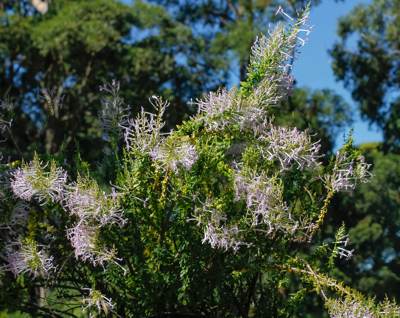Thorncroftia longiflora
Thorncroftia longiflora N.E.Br.
Family: Lamiaceae
Common names: None found
Introduction
Thorncroftia longiflora is both rare and remarkable. It is a versatile and attractive semi-succulent shrub which makes an excellent and showy garden subject, well suited for hot, dry and sunny gardens.

Description
Description
Thorncroftia longiflora is technically a succulent due to its semi-succulent stems and leaves. However, it behaves and grows much like a herbaceous shrub, forming a well-branched bush up to 80 cm high. It forms numerous fleshy stems which arise from a woody rootstock. These stems eventually become grey-brown and semi-woody as they mature, and are covered in fine hairs.
The opposite green semi-succulent leaves are elliptic to obovate in shape, 10-20 mm long, mildly toothed in the upper two-thirds, covered with short hairs, and attached to the stem by short stalks.
The pale pink flowers are 30-40 mm long and tubular, with petals flaring at the mouth with the lowermost bearing dark maroon spots or lines. The flowers are carried in dense terminal spikes forming an impressive display during autumn from March to May.

The small round dark brown or black seeds are nested in the base of the calyx, visible once the corolla tube has fallen off. They take a couple of months to ripen. Under warm and sunny conditions this species will grow fairly quickly, becoming a well-shaped shrub in one year, and they will last many years in the open ground.
Conservation Status
Status
According to the latest assessment by SANBI's Threatened Species Programme, this species is recognised as Rare.
Distribution and habitat
Distribution description
Thorncroftia longiflora has been well-known for a long time from its type locality around Barberton in Mpumalanga Province. With subsequent fieldwork, new populations have been discovered in Swaziland and as far south as northern KwaZulu-Natal. It is usually associated with rocky outcrops in grasslands, often growing in humus-filled crevices.
Derivation of name and historical aspects
History
The genus Thorncroftia is named in honour of George Thorncroft (1857-1934) who collected extensively botanically in the Barberton area. The specific name longiflora refers to the long corolla tube of the flowers. There are a total of 5 species in the genus Thorncroftia and all are endemic to South Africa. They were originally thought to be members of the closely-related genus Plectranthus. T.succulenta is also cultivated in gardens.
Ecology
Ecology
Because of its semi-succulent nature, this species is well adapted to growing in shallow soils and rock crevices. With the remarkable length of the floral tube, it is suspected that pollination is carried out by a unique pollinator, the long-proboscid fly, Prosoeca ganglbaueri, which has a proboscis that matches the length of the tube. This unique pollinator requirement may account for its rarity in the wild.

Uses
Use
There are no known medicinal or cultural uses for this plant.
Growing Thorncroftia longiflora
Grow
This is possibly one of the easiest and hardiest of all herbaceous South African garden plants to grow. It will survive under a vast spectrum of soil types and climatic conditions and is even frost-hardy. It prefers sunny positions, particularly afternoon sun, and thrives in subtropical temperatures which can be simulated by planting it amongst rocks or boulders which retain heat. It prefers wet summers and dry winters but will tolerate water during winter and will survive summer with minimal water. It does not require rich composted soils but will thrive if compost or true fertilisers are provided.
Due to their fragrant sage leaves, they naturally have very few pests and seem to be resilient to fungal and other pathogens. In their natural habitat it is a weevil called Apion rectangulum which attacks all species of Thorncroftia, causing thickened swellings in the stems. However, this is seldom seen in cultivation.
Propagation is easiest by cuttings which can be soft- or hardwood, and rooted (without the need for rooting hormone) at any time of the year, but spring and summer are best. The rooting medium should preferably be sandy and well-drained, but the cuttings should strike in any soil medium. They could also be rooted in water. Providing light shade and plastic covering to increase air humidity will speed up the rooting.
Seed should be collected during July or August and kept for sowing until September/October (spring in the southern hemisphere). They should be mixed with fine dry sand and sprinkled evenly over a suitable germination medium in a tray. Watering with a fungicide is advisable but not essential. Depending on the ambient temperatures they should germinate within 2-4 weeks. Seedlings grow vigorously and will quickly outgrow cuttings of the same age.
References
- Codd, L.E.W. 1985. Lamiaceae. Flora of southern Africa 28, 4:237-239.
- Potgieter, C.J. & Edwards, T.J. The occurrence of long, narrow corolla tubes in Southern African Lamiaceae. Systematics and Geography of Plants 71, 2, Plant Systematics and Phytogeography for the Understanding of African Biodiversity (2001), pp. 493-502. National Botanic Garden of Belgium .
- Leistner, O.A. (ed.). 2000. Seed plants of southern Africa: families and genera. Strelitzia 10. National Botanical Institute, Pretoria.
- Red list of South African plants. http://redlist.sanbi.org/species.php?species=1663-1
Credits
Adam Harrower
Kirstenbosch NBG
May 2013
Plant Attributes:
Plant Type: Shrub, Succulent
SA Distribution: KwaZulu-Natal, Mpumalanga
Soil type: Sandy, Clay, Loam
Flowering season: Autumn
PH: Acid, Neutral
Flower colour: Pink
Aspect: Full Sun
Gardening skill: Easy
Special Features:
Horticultural zones









Rate this article
Article well written and informative
Rate this plant
Is this an interesting plant?
Login to add your Comment
Back to topNot registered yet? Click here to register.